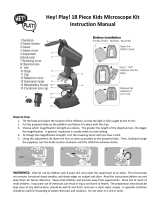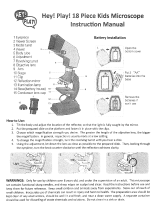
Welcome to the world of
Micro-Science
®
We take great pleasure in introducing you to the
world of Microscope. Microscope refers to an
instrument with lenses for making very small
near objects to appear larger. Because there
are innumerable living things that cannot be
seen with our naked eyes, microscope enables
these invisible living things to be seen
effortlessly.
The discovery of microscope goes back many
many years, and since the invention it has
exposed to a new field of exploration and study
as more attractive, and exquisite specimens as
you ever imagined can be evidenced.
In our new world of advanced technology, every
science from the most fundamental study of
biology to the highly skilled fields of
astro-physiology will use some form of
microscope. The mission of microscope
allows anyone from all walks of life to better
comprehend the complex forms of living
organisms or stagnant materials that construct
this world which we live in.
This microscope set will be the starting point to
your many hours of fruition as a hobby or
broader your opportunity to a wonderful world of
science.
Happy Experimenting!!!
Attention
The following information should be read carefully
in order to overcome confusions.
This microscope set is appropriate for children over
8 years old. If not applied, supervision of adult is
required as this set comprises of functional sharp
edge.
Before using the microscope, attentively and
carefully read the instructions, follow the guide, and
keep them for future direction in case you need
further helpful hints.
In any situation, be extremely cautious not to allow
chemicals to come into contact with any part of the
body, especially the eyes and mouth. Keep away
young infants and animals from the experiment.
Always, keep the microscope set in a place where
young infant is out of reach.
Eye protection is not provided, it can be obtained
from any science departments, and major shopping
outlets. Remember, in case of accidents please
seek medical advice.
Helpful Hints
• The essential component of the microscope is
the lens. Consequently, adequate care must
be exercised when dealing with the lens.
• Microscope should be stored in a moisture
free place. Because moisture build up on the
lenses will reduce the light intensity.
• After it is utilized, protect the microscope from
dust by covering the microscope or putting it
back into the box.
• If the lens gets dusty or dirty, it is suggested to
clear off the lens surface with a soft cotton
cloth or tissue. Do not rub the lens with a
finger or unclean cloth.
• If a microscope is not used for a long period of
time, discharge the light source batteries.
Always keep instructions to hand.
Components of a Microscope
1. Eyepiece
2. Focusing knob
3. Body tube
4. Objective lens
5. Arm
6. Stage
7. Clip
8. Clip adjustors
9. Power switches for the illuminator
10. Base
11. Magnification revolving turret
Procedures
1. Firstly, insert 2 AA penlite dry cells batteries in
the arm of the microscope. You will need to
use a screwdriver to open the battery case
cover. (Batteries are not included)
2. Now put the prepared slide on the stage, and
fasten it in place with the clip adjustors.
3. Next, choose the magnification strength you
desire. In general, it is recommended to begin
with lower magnification for easier focusing.
To change the magnification setting, turn the
magnification revolving turret until you hear a
click.
4. Turn on the illuminator for viewing.
5. Look through the eyepiece and slowly adjust
the focusing knob until the object on the slide
becomes clear. To view different part of the
slide, adjust the clip adjustors until the desired
object appears through the eyepiece.
1
3
11
4
6
7
8
10
2
9
5











